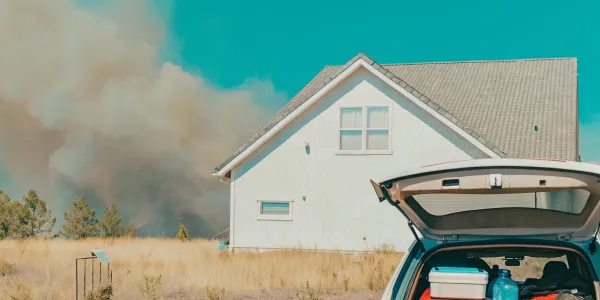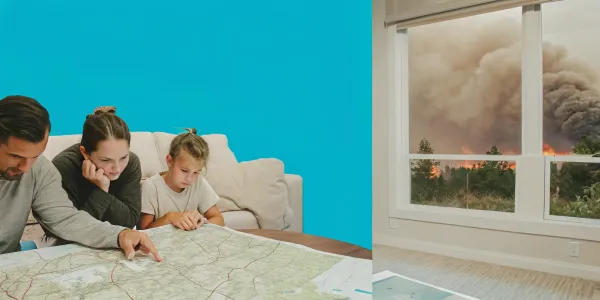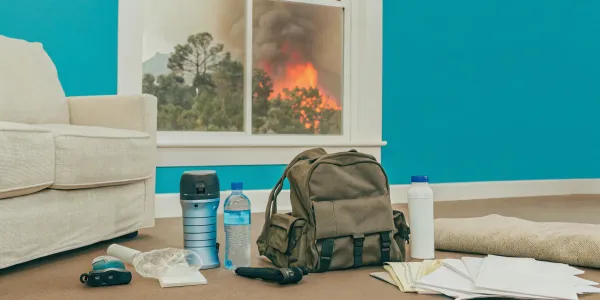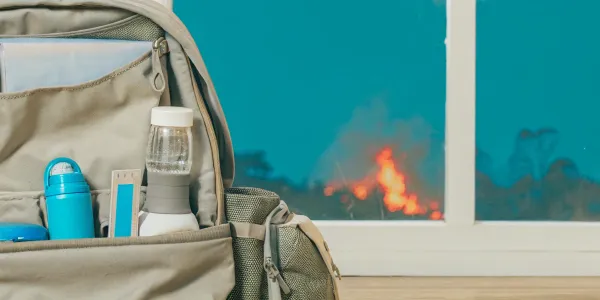What to Put in a Wildfire Go Bag: Essential Checklist
Get a clear, practical checklist for what to put in a wildfire go bag so your family is ready to evacuate safely with the essentials when every minute counts.
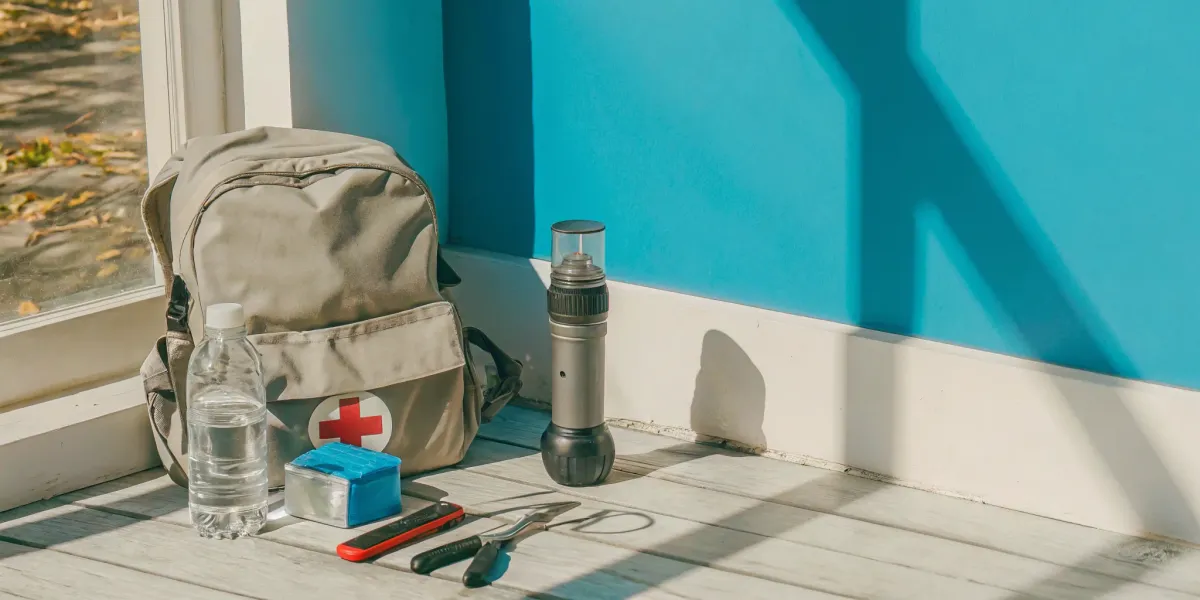
The smoke is on the horizon, and the wind is picking up. Suddenly, an official is at your door telling you it’s time to leave—now. In this high-stakes moment, you won't have time to calmly gather essentials. You'll be running on adrenaline, likely forgetting critical items like medications or important documents in the rush. A prepared Go Bag completely changes this scenario. It’s the difference between a frantic, disorganized exit and a calm, orderly evacuation. Knowing your family has everything they need provides invaluable peace of mind. We’ll break down exactly what to put in a wildfire go bag so you can be ready to act, not react.
Key Takeaways
- Focus on the First 72 Hours: A well-packed Go Bag enables immediate evacuation by containing critical supplies like water, food, medications, and copies of important documents, which eliminates high-stress, last-minute decisions.
- Make It Personal and Keep It Current: Go beyond a generic checklist by tailoring your bag to the unique needs of every family member, including pets and older adults. Schedule regular reviews to swap out expired items and adjust for seasonal changes.
- Think Beyond the Bag: True preparedness involves a multi-layered plan. Store your Go Bag for grab-and-go access, keep a secondary kit in your car, back up vital documents digitally, and create a family communication plan to ensure everyone stays safe and connected.
Why You Need a Wildfire Go Bag
When a wildfire threatens your home, the time for preparation is over. The moments following an evacuation order are filled with stress and uncertainty, and every second counts. This is where a Go Bag becomes your most important tool. It’s a pre-packed kit with everything you and your family need to leave at a moment’s notice and survive for at least 72 hours. Having one ready shifts the dynamic from panic to action. Instead of scrambling to find essentials, you can focus on what truly matters: getting your family to safety. Understanding what happens during an evacuation and why the first few minutes are so critical will show you why this simple step is non-negotiable for anyone living in a high-risk fire area.
What Happens During an Evacuation Order?
An evacuation order isn't a suggestion—it's an urgent directive from emergency officials to leave your home immediately because your life is in danger. There is no time to debate what to take. According to CAL FIRE, a Go Bag is an emergency supply kit you prepare before a disaster strikes. Its purpose is to help you evacuate quickly and have critical supplies if you need to be away from home for a while. This includes irreplaceable documents, medications, water, and other essentials. By preparing this kit in advance, you eliminate panicked, last-minute decision-making, which can lead to forgetting vital items and wasting precious time.
Why the First 30 Minutes Matter Most
Wildfires are dangerously unpredictable and can spread with astonishing speed. The first 30 minutes after an evacuation order are often the most chaotic and critical. As one report notes, this window is crucial because fast-moving flames can quickly cut off escape routes. Roads become congested with traffic, smoke can reduce visibility to near zero, and emergency personnel need clear access to fight the fire. Your ability to act quickly and safely depends entirely on your level of preparation. A ready-to-go bag means you can grab it, get your family and pets in the car, and leave. Wasting that critical time searching for a phone charger or prescription bottle is a risk you can't afford to take.
Your Wildfire Go Bag Checklist: The Essentials
When an evacuation order comes, you won’t have time to think. Having a well-stocked go bag is one of the most important steps you can take to protect your family. This bag should contain everything you need to survive for at least 72 hours. Think of it as your lifeline, packed with the essentials that will keep you safe, informed, and comfortable until the immediate danger has passed.
Building your kit doesn’t have to be overwhelming. We’ve broken down the core components every go bag needs. Start with these basics and then customize the bag for your family’s specific needs. The goal is to have a single, reliable bag you can grab without a second thought. A complete emergency supply kit is your foundation for a solid evacuation plan.
Documents, Cash, and Keys
In an emergency, you’ll need to prove your identity, access money, and have a way to secure your property. Pack copies of essential papers like birth certificates, passports, social security cards, and insurance policies in a waterproof bag. It’s also smart to have digital copies saved to a password-protected flash drive or secure cloud service. Include a set of spare car and house keys. Don’t forget cash in small bills, as power outages can make credit cards and ATMs useless.
Food and Water
You need enough food and water to last each person for at least three days. The standard recommendation is one gallon of water per person, per day. For food, choose non-perishable items that don’t require cooking or refrigeration, like protein bars, dried fruit, and canned goods with pull-tabs. Remember to pack a can opener if needed. Make sure to check expiration dates every six months and replace items as necessary.
First Aid and Medications
A well-stocked first aid kit is non-negotiable. You can buy a pre-made kit and add your own personal items to it. Most importantly, include a 7-day supply of any prescription medications your family members need, along with a list of dosages. Don’t forget over-the-counter medications like pain relievers and allergy medicine. If you wear glasses or contacts, pack an extra pair and solution.
Communication and Power
Staying informed is critical during a wildfire. Since cell service and power can be unreliable, your go bag should have multiple ways to get information and stay connected. Pack a portable battery bank and charging cables for your phone. A hand-crank or battery-powered NOAA Weather Radio is also essential for receiving emergency alerts when other communication channels are down. Include a flashlight or headlamp with extra batteries.
Personal Hygiene Items
Maintaining personal hygiene can provide a sense of comfort and normalcy in a stressful situation, and it’s important for preventing illness. Pack travel-sized toiletries for each family member, including toothbrushes, toothpaste, soap, and deodorant. Other useful items include toilet paper, wet wipes, feminine hygiene supplies, and hand sanitizer. A small, quick-dry towel is also a great addition.
Safety Gear and Tools
To protect yourself from smoke and embers, include an N95 respirator mask for everyone in your household. Sturdy gloves can protect your hands from hot surfaces or debris, and a multi-tool can be useful in countless situations. It’s also a good idea to pack a whistle to signal for help if you become separated or trapped. This basic safety gear can make a significant difference when you’re navigating a hazardous environment.
Tailor Your Go Bag for Your Family's Needs
The basic go bag checklist is a great starting point, but it’s just that—a start. Every family is different, and your emergency kit needs to reflect your unique circumstances. A household with a newborn, a teenager, and a golden retriever has very different needs than a retired couple. Taking the time to customize your go bags for each person (and pet) is one of the most important steps you can take. It’s about ensuring not just survival, but also comfort and a sense of normalcy during a chaotic and stressful time.
Think through the daily needs of everyone in your home. Who relies on prescription medication? Do you have an infant who needs formula and diapers? Does an older parent depend on a walker or hearing aids? What about your pets? They are completely dependent on you to pack their food, water, and medication. A well-tailored go bag means you won’t be scrambling for critical items when every second counts. This personalized approach turns a generic emergency kit into a true lifeline for your family. Creating a family communication plan alongside your go bags ensures everyone knows what to do and how to connect if you get separated.
Prescriptions and Medical Supplies
When an evacuation order comes, you won’t have time to run to the pharmacy. Your go bag must include any necessary medicines or prescriptions for every member of your family. Pack at least a seven-day supply of all essential medications. It’s also smart to include a waterproof bag with copies of your prescriptions, your doctor’s name and phone number, and your pharmacy’s information. Don’t forget over-the-counter basics like pain relievers, allergy medicine, and antacids. If anyone uses an inhaler or EpiPen, pack extras. Finally, remember vision needs: include a spare pair of glasses, extra contact lenses, and a travel-sized bottle of contact solution. Having these medical essentials on hand provides critical peace of mind.
What to Pack for Your Pets
Your pets are part of the family, and they need their own go bag. During an emergency, their routine is disrupted, which can cause a lot of stress. The most important items are at least three to seven days' worth of food and water for your pets. Pack their food in an airtight, waterproof container and bring a collapsible bowl. You’ll also need a sturdy leash, a harness or collar with up-to-date ID tags, and a pet carrier labeled with your contact information. Include any medications they take, along with copies of their vaccination records. The ASPCA recommends adding a favorite toy or blanket to help keep them calm and comfortable in an unfamiliar environment.
Essentials for Children and Infants
Evacuations are especially frightening for children. Packing items specifically for them can make a huge difference. For babies, make sure to include extra clothes, diapers, and formula. If you use powdered formula, pack ready-to-feed bottles, as you may not have access to safe, clean water for mixing. Don’t forget baby wipes, bottles, and any special creams or medications. For toddlers and older kids, pack comfortable clothes, snacks they enjoy, and something to keep them occupied, like a favorite book, a small puzzle, or a deck of cards. A familiar stuffed animal or blanket can also provide immense comfort. Including these items helps maintain a sense of routine and security for them.
Items for Older Adults
If you have older adults in your household, their go bag requires special attention. Beyond their daily medications, consider including items like hearing aids with extra batteries, spare eyeglasses, and any mobility aids they may need, such as a cane or a lightweight foldable walker. It’s also helpful to have a written list of all their medical conditions, allergies, medications, and dosages, along with contact information for their doctors. If they use specific medical equipment, like a glucose meter or blood pressure monitor, be sure to pack it. The Federal Emergency Management Agency (FEMA) provides detailed checklists to help you prepare for the unique needs of older family members, ensuring they remain safe and supported during an evacuation.
How to Pack and Store Your Go Bag
Once you’ve gathered all your essential items, the next step is to pack and store them correctly. How you organize your go bag is just as important as what’s inside. When an evacuation order comes, you won’t have time to search for a misplaced bag or dig through a disorganized mess to find a flashlight. The goal is to create a system that allows you to grab your kit and leave your home in minutes, confident that you have everything you need.
Pick the Right Bag
When it comes to an emergency, your bag should be a tool, not a burden. Choose a durable backpack for each member of your family who can carry one. A backpack keeps your hands free, which is critical for holding onto children, pets, or handrails while navigating uncertain terrain. Look for a comfortable, sturdy bag with multiple compartments to help with organization. While a rolling suitcase might seem like a good idea, it can be useless if you have to evacuate on foot over debris or unpaved ground. As CAL FIRE suggests, your emergency supply kit should be easy to carry and access when you need it most.
Find the Best Place to Keep It
Your go bag does you no good if it’s buried in the back of a closet or up in the attic. You need to store it in a cool, dry place where you can grab it without a second thought. Good options include a coat closet near your main exit, inside your garage by the door to your car, or even in the trunk of your primary vehicle. The key is consistency and accessibility. Make sure every member of your household knows exactly where the go bags are stored. This simple step eliminates confusion and saves precious time during a high-stress evacuation.
Keep Your Supplies Dry
Protecting your go bag’s contents from water is a simple but often overlooked step. A sudden downpour during an evacuation or even a leaky water bottle inside your pack can ruin critical documents, electronics, and medical supplies. Use waterproof compression sacks or even simple zip-top plastic bags to protect important items. Group documents, batteries, matches, and medications into separate waterproof bags before placing them in your backpack. This small bit of prep ensures your most vital supplies will be safe and functional, no matter the conditions you face.
Organize for Grab-and-Go Access
A well-organized bag helps you stay calm and find what you need quickly. Use small pouches or packing cubes to group related items together—create a dedicated pouch for first aid, another for hygiene items, and one for documents and cash. This prevents you from having to empty your entire bag to find a bandage or a phone charger. Place heavier items like water and food at the bottom of the backpack, and keep items you might need first—like a flashlight, N95 masks, or a map—in an easily accessible outer pocket. A thoughtful packing strategy is a key part of building your kit.
Common Go Bag Mistakes (and How to Avoid Them)
Just having a Go Bag isn't enough—it needs to be packed correctly to be truly effective when seconds count. Many well-intentioned people make a few common mistakes that can undermine their preparedness efforts. Thinking through these pitfalls now will save you critical time and stress during an actual evacuation. Let's walk through the most frequent errors and how you can easily avoid them, ensuring your Go Bag is a reliable tool for your family's safety.
Mistake #1: Overpacking
It’s tempting to pack for every possible scenario, but a bag that’s too heavy can be a liability. If you have to evacuate on foot or carry it for any distance, you’ll regret every extra pound. The goal is a kit that is lightweight and portable, with essentials for the first 72 hours. A good rule of thumb is to pack only what you can comfortably carry for at least 15 minutes. Use backpacks to keep your hands free and distribute the weight among several smaller, manageable bags for each family member instead of one massive one.
Mistake #2: Forgetting Important Documents
In the chaos of an evacuation, your wallet might be the last thing on your mind. But after the immediate danger has passed, you will need identification, financial information, and proof of ownership to start the recovery process. Forgetting these documents can create a bureaucratic nightmare. Make sure your Go Bag includes physical copies of critical papers like driver’s licenses, passports, birth certificates, social security cards, insurance policies, and property deeds. Store them in a waterproof bag. For extra security, create digital backups and save them to a password-protected cloud service or an encrypted USB drive that you keep in your bag.
Mistake #3: Skipping Personal Items
While survival gear is the priority, don't underestimate the importance of small personal items. An evacuation is a deeply stressful event, and having a few comforts can make a significant difference, especially for children. Beyond the basics, consider items that support your well-being. This could include a change of seasonally appropriate clothes, a book or a small toy for a child, a notepad and pen, or even a spare pair of glasses. As PreparedBC suggests, practical items like an emergency blanket and a whistle for signaling are also crucial personal additions that often get overlooked.
Mistake #4: Storing It in the Wrong Place
A perfectly packed Go Bag is useless if you can't find it or reach it when an evacuation order is issued. Stashing it in the back of a cluttered closet, in the attic, or deep in the basement is a common mistake. Your Go Bag needs to be in a consistent, accessible location where you can grab it and leave without a second thought. Good spots include a front hall closet, right by the garage door, or in the trunk of your primary vehicle. The most important thing is that everyone in your household knows exactly where your emergency supply kit is located.
Keep Your Go Bag Ready
Creating your go bag is a huge step, but it’s not a one-and-done task. Think of it as a living kit that needs to adapt along with your family and the seasons. An outdated or poorly maintained bag can fail you when you need it most. The key is to make its upkeep a simple, repeatable habit. By regularly checking and updating your supplies, you ensure that when an evacuation order comes, you can grab your bag with confidence, knowing it has exactly what you need to stay safe and comfortable. This small investment of time pays off with invaluable peace of mind.
Schedule Regular Check-Ups
Set a recurring date on your calendar to review your go bag—at least once a year is a good starting point. A great time to do this is when you change your smoke detector batteries. During your check-up, think about what has changed in your family’s life over the past year. Did you welcome a new baby or a pet? Have your children outgrown the clothes you packed for them? Do you or a family member have a new prescription or medical need? Use this time to update your supplies to reflect your family's current needs, ensuring everyone is accounted for.
Swap Out Expired Items
Many essential items in your go bag have a shelf life. During your regular check-up, make a point to check the expiration dates on all food, water, medications, and first-aid supplies. Batteries can also lose their charge over time, so it’s wise to replace them annually. To make this process easier, consider using a permanent marker to write the expiration date in large numbers on packaged food or medical supplies. This simple habit makes it quick to see what needs to be replaced, so you’re not caught with spoiled food or dead batteries during an emergency.
Update It for the Season
Wildfire season often peaks during the hot, dry months, but emergencies can happen anytime. Your go bag should reflect the current season. In the fall and winter, you might need to add warmer layers, rain gear, extra blankets, or waterproof gloves. In the spring and summer, you may want to pack extra water, sunscreen, insect repellent, and lightweight, breathable clothing. Getting your kit ready well before a disaster strikes means you’re prepared for the specific environmental conditions you’re likely to face if you need to evacuate your home.
Practice Your Evacuation Drill
Your go bag is only one part of a successful evacuation. Knowing exactly what to do in a high-stress situation is critical. Use Red Flag Warning days, when fire danger is highest, as a reminder to review your plan. Walk through the steps: Where is the go bag? Who is responsible for grabbing it? Who is in charge of the pets? What is your primary evacuation route, and what are your backup options? Practicing these steps helps build muscle memory, so your family can act quickly and calmly. This drill is a core part of a complete Wildfire Action Plan that keeps everyone safe.
Go Beyond the Bag: Next-Level Preparedness
A well-stocked Go Bag is your foundation for a safe evacuation, but true preparedness doesn’t stop there. Once you have your essentials packed, it’s time to think bigger. A wildfire evacuation is a dynamic, often chaotic event, and having a multi-layered strategy ensures you’re ready for whatever comes your way. This means preparing for scenarios where you aren’t home when the order comes, protecting your most critical information, and making sure your family knows exactly what to do without a moment’s hesitation.
These next steps move you from simply having supplies to having a resilient, comprehensive plan. They are the difference-makers that provide peace of mind when you need it most, ensuring your family’s safety and simplifying your recovery process after the immediate threat has passed. Think of your Go Bag as your personal survival kit for the first 72 hours. The strategies that follow are about safeguarding your life and future beyond that initial window. They address the practical realities of displacement, communication breakdowns, and the long road to recovery. By taking these additional measures, you build a stronger shield against the uncertainty of wildfire season.
Your Car Emergency Kit
An evacuation order won’t always arrive when you’re conveniently at home next to your perfectly packed Go Bag. You could be at work, running errands, or already on the road. That’s why keeping an emergency supply kit in your car is non-negotiable. This kit doesn’t have to be a duplicate of your main bag, but it should contain core survival items. Think water bottles, non-perishable snacks, a basic first-aid kit, a phone charger or power bank, a flashlight, and a warm blanket. Having these items staged in your vehicle means you’re prepared to evacuate from anywhere. It’s your safety net, ensuring that even if you can’t get home, you have the resources to get to a safe location.
Create Digital Backups of Your Documents
In the rush to evacuate, it’s easy to forget a folder of papers. Even if you remember it, physical documents can be lost or destroyed. Creating digital copies of your most important documents is one of the most powerful steps you can take to protect your future. Take the time to scan or photograph items like birth certificates, passports, social security cards, driver’s licenses, insurance policies, and property deeds. Store these files securely in a password-protected cloud service or on an encrypted USB drive that you keep with your Go Bag. This simple action ensures you have everything needed to file insurance claims and begin the recovery process without delay, no matter what happens to the physical copies.
Plan for a Longer Evacuation
While we all hope an evacuation will be short, you need to prepare for the possibility of being away from home for several days. Your Go Bag should contain at least a three-day supply of non-perishable food and water. The standard recommendation is one gallon of water per person, per day. But supplies are only part of the equation. You also need a destination. Talk with family and friends who live outside your immediate area to arrange a potential place to stay. Identify pet-friendly hotels along your evacuation routes. Having a clear idea of where you can go removes a massive layer of stress and uncertainty, allowing you to focus on getting there safely.
Build Your Family Communication Plan
When a wildfire threatens, chaos can make communication difficult. Cell towers may become overloaded or damaged, and your family members could be in different locations. A pre-established communication plan is essential. First, designate two meeting spots: one just outside your home for immediate emergencies and another outside your neighborhood in case you can’t return to the area. Second, choose an out-of-state friend or relative as a central point of contact. It’s often easier to make a long-distance call than a local one during a disaster. Make sure everyone in your family has this contact’s number and understands the plan. A clear wildfire action plan ensures everyone knows how to reconnect.
Related Articles
- Wildfire Car Emergency Kit: The Ultimate Checklist
- 5-Minute Evacuation Checklist: What to Grab Now
- The Essential 14-Day Emergency Kit List [Checklist]
Frequently Asked Questions
How heavy is too heavy for a Go Bag? A good rule of thumb is that your Go Bag should be light enough for you to carry comfortably for at least 15 minutes. If you have to evacuate on foot, a bag that’s too heavy will slow you down and become a liability. Instead of packing for every imaginable scenario, focus on the essentials needed for 72 hours. If you find your bag is too heavy, consider distributing the weight by creating smaller, manageable backpacks for each family member who can carry one.
Should I have one big Go Bag for the whole family or individual ones? The most effective strategy is often a hybrid approach. It’s a great idea to have a primary Go Bag that contains shared items like the first-aid kit, water, and a weather radio. However, each person should also have their own smaller backpack with personal items like prescription medications, a change of clothes, a flashlight, and a comfort item for children. This ensures everyone has their critical personal supplies and helps distribute the weight of heavier, shared resources.
What's the most important thing to do after my Go Bag is packed? Once your bag is ready, the most critical next step is to create and practice your family's communication and evacuation plan. A Go Bag is a tool, but a plan is your strategy. Everyone in your household needs to know where the bags are stored, what your evacuation routes are, where you will meet if you get separated, and who your out-of-state emergency contact is. A complete Wildfire Action Plan turns your preparation into a coordinated response.
How is a car emergency kit different from my main Go Bag? Think of your main Go Bag as your comprehensive kit for evacuating from home. Your car kit is your safety net for when you aren't home when an order is issued. It doesn't need to be a full duplicate, but it should contain core survival items like water, snacks, a first-aid kit, a phone charger, and a blanket. This ensures that no matter where you are, you have the basic resources to get to a safe location without having to return home.
How often do I really need to check my Go Bag? You should review and update your Go Bag at least once a year, but twice a year is even better. A simple way to remember is to do it when you change your clocks for daylight saving time or when you test your smoke detectors. During your check-up, swap out any expired food, water, and medications, replace old batteries, and update clothing for the current season. This regular maintenance ensures your kit is always ready to go when you need it most.

